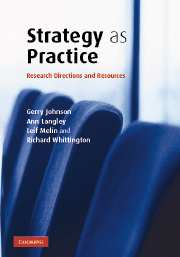Book contents
- Frontmatter
- Contents
- List of Figures
- Preface
- Authors' biographies
- Acknowledgements
- Part I
- Part II Illustrative papers
- 4 Technology as an occasion for structuring: evidence from observations of CT scanners and the social order of radiology departments
- 5 Making fast strategic decisions in high-velocity environments
- 6 In search of rationality: the purposes behind the use of formal analysis in organizations
- 7 Sensemaking and sensegiving in strategic change initiation
- 8 Business planning as pedagogy: language and control in a changing institutional field
- 9 Strategizing as lived experience and strategists' everyday efforts to shape strategic direction
- 10 Organizational restructuring and middle manager sensemaking
- 11 From metaphor to practice in the crafting of strategy
- Part III
- References
- Index
6 - In search of rationality: the purposes behind the use of formal analysis in organizations
Published online by Cambridge University Press: 10 March 2010
- Frontmatter
- Contents
- List of Figures
- Preface
- Authors' biographies
- Acknowledgements
- Part I
- Part II Illustrative papers
- 4 Technology as an occasion for structuring: evidence from observations of CT scanners and the social order of radiology departments
- 5 Making fast strategic decisions in high-velocity environments
- 6 In search of rationality: the purposes behind the use of formal analysis in organizations
- 7 Sensemaking and sensegiving in strategic change initiation
- 8 Business planning as pedagogy: language and control in a changing institutional field
- 9 Strategizing as lived experience and strategists' everyday efforts to shape strategic direction
- 10 Organizational restructuring and middle manager sensemaking
- 11 From metaphor to practice in the crafting of strategy
- Part III
- References
- Index
Summary
Abstract
This paper describes the results of a study that examines how formal analysis is actually used in practice in three different organizations. Four main groups of purposes for formal analysis – information, communication, direction and control, and symbolic purposes – are identified and related to the nature of the social and hierarchical relationships between those who initiate analysis, those who do it, and those who receive it. It is concluded that, far from being antithetical as often assumed, formal analysis and social interaction are inextricably linked in organizational decision making and that different structural configurations may generate different patterns of use of analysis.
Editors' introduction
This paper focuses on a key aspect of strategy practice: strategic analysis. It is therefore centrally about the concerns of the Strategy as Practice perspective. It also examines practice in relation to different organizational contexts and seeks to understand the relationship between the two. Further, it raises important issues of research design and methodology in relation to our field. It also raises other issues for consideration in comparison to other papers included in the book: the extent and nature of theorizing and appropriateness of levels of analysis for example. And, as with the Barley paper (chapter 4), it is interesting to ask just how much the quantitative analysis adds to the qualitative analysis.
Paper summary
The departure point for this paper is to point out that surprisingly little is known about the use of formal strategic analysis in organizations: ‘Is it in fact used at all? And, if so, when and why?’ (598).
Information
- Type
- Chapter
- Information
- Strategy as PracticeResearch Directions and Resources, pp. 121 - 136Publisher: Cambridge University PressPrint publication year: 2007
